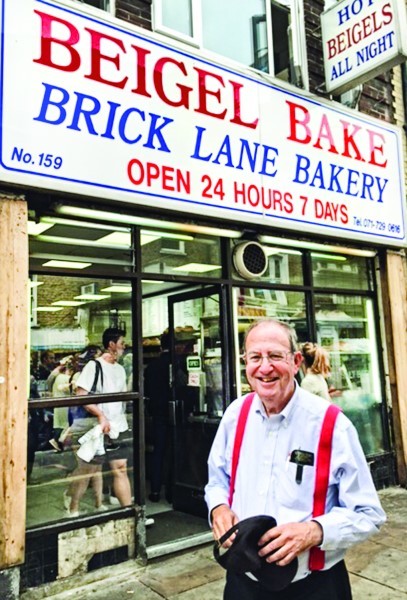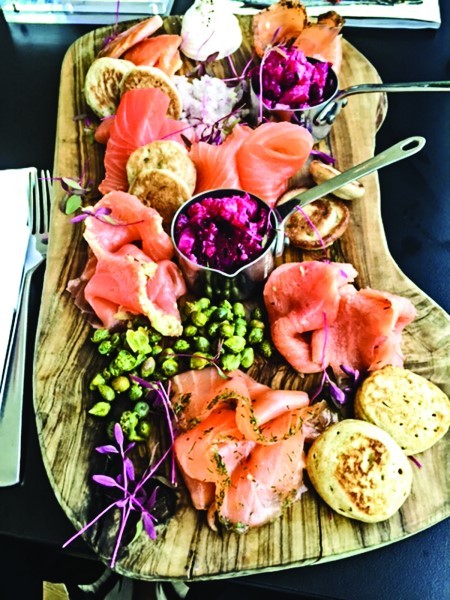Adventures in London: The Jewish dimension
LONDON – Think Jewish, and eat well.
That’s my spin on visiting this magnificent city.
Of course, embrace the essence of British Parliament. Churchill’s Underground War Rooms. Buckingham Palace. Shakespeare’s Globe Theatre.
Is there anything more British than strawberries and cream at Wimbledon, or tea in fine china at the Fortnum & Mason food emporium? Quaff an ale at a pub. And don’t forget fish and chips.
Still, if you’re Jewish, there are additional dimensions:
• The Jewish Museum London.
• A walking tour of the historic East End, which was the heart of Jewry here before Jews grew more affluent and moved to upscale neighborhoods like Golders Green.
• Synagogues.
And let’s not forget the food:
A bagel stuffed with hot salt beef – we call it corned beef – at the 24-hour Beigel Bake Brick Lane Bakery, or a dazzling platter of smoked salmon at Formans near the 2012 Olympic Stadium. Plus, modern, elegant gourmet versions of Middle East cuisine at hip eateries – Ottolenghi and Honey & Co. – owned by famous chefs who moved here from Israel. You very likely own their cookbooks.
The museum, in the Camden Town neighborhood, offers a good introduction. You will learn that Jews came to Britain at least as far back as the Norman conquest of 1066 but were expelled in 1290 and not welcomed back until 1656.
The museum contains some extraordinary artifacts, such as a carved, gilded Italian 17th century synagogue ark that somehow found its way to a British castle and was used as a wardrobe; an elaborate 18th century book used to record synagogue donations; and a magnificent 1920s hand-painted colorful banner from the London Jewish Bakers Union. (UNITY. STRENGTH… BUY BREAD WITH THE UNION LABEL.)
An exhibit about the 1938-39 British Kindertransport project that rescued children from Nazi persecution is made more poignant by comments from young museum visitors as to how they would feel if they were parents sending their children to an uncertain future in a foreign land. “I would put in a note for her to keep with her when she’s sad,” wrote one visitor.
If you’re headed to Britain, get yourself a copy of “Jewish London” by Rachel Kolsky and Roslyn Rawson. On a 2013 visit, the book prompted me to visit the small but fascinating Czech Memorial Scrolls Museum in Kent House, which is also home to the Westminster Synagogue. You learn of the Torahs rescued for safekeeping from the Nazis, most of which are now on permanent loan to synagogues and other institutions around the world. In fact, one of them is in my own Temple Habonim in Barrington.
On this most recent visit to London, I went on an East End tour operated by London Walks (walks.com) and led by Rachel Kolsky. One emphasis is on institutions the Jewish community established to help immigrants and prevent them from becoming a burden on the state. We paused, for example, at an ornate 1902 brick building bearing the inscription, “Soup Kitchen for the Jewish Poor.’’ There’s a symbolic soup tureen above the front door.
The tour also brought us to the 1701 Bevis Marks Synagogue, oldest operating synagogue in the United Kingdom. Its pillars, balconies, and elaborate candle chandeliers may remind you of Touro Synagogue in Newport. Overall, Touro is airier, Bevis Marks, with its long dark, straight back benches, more severe.
At the end of the walking tour, Kolsky gave me precise directions for ambling down Brick Lane, where block after block of what once were Jewish businesses now features establishments like Al-Halal Fried Chicken and The Famous Curry Bazaar (“Authentic Indian & Bangladesh Cuisine”). I skipped a business called Beigel Shop, alighting at number 159 – Beigel Bake Brick Lane Bakery.
This was one of the best things that ever happened to me.
Dozens of customers crowded inside, snaked along shelves and display cases bulging with bagels, challahs, rye breads and pastries, and placed their orders. The line moved quickly. “Next, please.” “Mustard?” “11 pounds, 10 pence, please.” Many folks were ordering bagels to eat on the spot – at a tiny counter or on the sidewalk outside. You could get a bagel filled with smoked salmon, or tuna, or even Nutella. But the specialty of the house is a bagel stuffed with thick slices of salt beef, with spicy mustard, and slabs of sweet pickle, which of course is what I ordered. Employees took turns standing near the front window doing the carving and the stuffing. It was mesmerizing to watch, and the eating was pure ecstasy.
The bagel was perfect – soft, yet chewy – and the meat was fatty, but not excessively so.
It would be some time before I would again eat anything so satisfying.
Yes, about five hours.
Welcome to Formans, the sleek restaurant with a black and silver motif in the H. Forman & Son smokehouse that was built when the site of the previous factory was taken for the 2012 Olympics. The main stadium is used by the West Ham United soccer team and you can see the structure, now called London Stadium, from the restaurant.
The company, whose salmon comes from Scotland and whose building looks like a cross-section of a salmon, has been in the East End since it was founded in 1905 by the Russian-Jewish great-grandfather of Lance Forman, the current owner. Lance engaged in a spectacular relocation battle with Olympic and government authorities and wrote a remarkably interesting book about it, “Forman’s Games,” which is for sale in the restaurant. I had had some email correspondence with Forman, and when I arrived at the restaurant for an early supper, manager Inda Mourino was waiting for me – and he waited on me.
I had come during “lounge” hours – the main dining room wasn’t to start serving for awhile, but Mourino let me sit in it anyway. A man and woman on an outdoor terrace were the only other customers in sight. It was odd – but wonderful.
I ordered the salmon platter for two, which Mourino said was not all that big. But in fact it was as large as a hockey rink, and it was gorgeous. There were so many varieties of salmon and gravlax, accompanied by miniature buckwheat blinis, pumpernickel, capers, chopped shallots and crème fraiche, that I had to draw a map to keep it all straight.
Mourino said, “You can’t get it any fresher.”
I dug into the various offerings, including chunks of royal fillet, sliced wild salmon, hot smoked salmon, wasabi and ginger gravlax, and kept chugging away. I was savoring every bite and every taste sensation, and, indeed, I was so immersed in the task – I actually finished about 80 percent – that at one point I looked up and out the window and was almost surprised to see the stadium; I had forgotten all about it. I won’t soon forget the meal.
The first dinner my wife Elizabeth and I shared on our trip was at one of the four Ottolenghi eateries here. It’s very probable you own “Jerusalem,” the cookbook Yotam Ottolenghi, who grew up on that city’s Jewish side, authored with Sami Tamimi, who grew up on the Arab side. Together, they opened these London establishments. We went to the one on Motcomb Street in Belgravia.
Most customers of this shop order takeout from a sumptuous array of offerings that look like they jumped off the pages of glossy food magazines, but we savored ours at a communal table in back.
I chose beef kabob, roasted eggplant and tabbouleh.
Elizabeth chose carrot fennel sweet potato fritters and mixed green beans with walnuts.
We also treated ourselves to salt caramel and chocolate brittle, a date and oat bar, and a dark cake topped with pistachios. I’m not complaining, but this required ignoring such other options as a white chocolate cheesecake tart with raspberry compote or malted banana tea cake with dulce de leche.
Later in the trip I returned for breakfast: a superb, tangy shakshuka, the North African egg, tomato and pepper dish popular in Israel. I nursed a cappuccino and perused my London Daily Telegraph, and I felt I was living large.
But the dinner we enjoyed at Honey & Co. surpassed everything. This restaurant is run by former top Ottolenghi employees, the Israeli husband-and-wife team of Itamar Srulovich and Sarit Packer.
This place is tiny, accommodating perhaps 30 diners, including the outdoor space. The kitchen is downstairs. Yellow and blue “Honey & Co.” cookbooks line a shelf that hovers over customers. Elizabeth and I were nestled in a corner with gorgeous desserts beckoning us from a counter above.
For appetizers, we shared a collection of such Middle East offerings as falafel with tahini and hummus, whipped feta and beans, pickles, olives, and breads with olive oil. There were cheese buns, and a sweet corn dish, and, beyond everything else, an ethereal peach and goat cheese salad.
My main course was pomegranate chicken with cracked wheat, dried currant and herb salad. It was a work of art for the eye to behold, and a delight for the palate. The same for Elizabeth’s slow-cooked lamb shoulder with pita, mint, yogurt, and pomegranate.
The absolute highlight was the extravagantly rich, sensuous, beautiful dessert we shared: a generous helping of “cold cheesecake” – a mix of cream cheese, heavy cream, confectioner’s sugar, honey, creamy feta, and vanilla – over a bird’s nest of crunchy, stringy kadaif pastry, drizzled with raw honey, and garnished with blueberries and almonds.
It is the restaurant’s signature dish. The full recipe and directions – “Feta & honey cheesecake on a kadaif pastry base” – take up two full pages in the restaurant’s namesake cookbook. Three if you include the picture.
The book calls this dessert “quite ambitious for home preparation.”
Take the hint. Fly to London and order it in the restaurant.
It’s worth the trip.
M. CHARLES BAKST is a retired Providence Journal political columnist.













